12 Best Carbon Removal Offsets (Complete 2024 List)
Affiliate Disclosure
Hey fellow impactful ninja ?
You may have noticed that Impactful Ninja is all about providing helpful information to make a positive impact on the world and society. And that we love to link back to where we found all the information for each of our posts.
Most of these links are informational-based for you to check out their primary sources with one click.
But some of these links are so-called "affiliate links" to products that we recommend.
Why do we add these product links?
First and foremost, because we believe that they add value to you. For example, when we wrote a post about the environmental impact of long showers, we came across an EPA recommendation to use WaterSense showerheads. So we linked to where you can find them. Or, for many of our posts, we also link to our favorite books on that topic so that you can get a much more holistic overview than one single blog post could provide.
And when there is an affiliate program for these products, we sign up for it. For example, as Amazon Associates, we earn from qualifying purchases.
What do these affiliate links mean for you?
First, and most importantly, we still only recommend products that we believe add value for you.
When you buy something through one of our affiliate links, we may earn a small commission - but at no additional costs to you.
And when you buy something through a link that is not an affiliate link, we won’t receive any commission but we’ll still be happy to have helped you.
What do these affiliate links mean for us?
When we find products that we believe add value to you and the seller has an affiliate program, we sign up for it.
When you buy something through one of our affiliate links, we may earn a small commission (at no extra costs to you).
And at this point in time, all money is reinvested in sharing the most helpful content with you. This includes all operating costs for running this site and the content creation itself.
What does this mean for me personally?
You may have noticed by the way Impactful Ninja is operated that money is not the driving factor behind it. It is a passion project of mine and I love to share helpful information with you to make a positive impact on the world and society. However, it's a project in that I invest a lot of time and also quite some money.
Eventually, my dream is to one day turn this passion project into my full-time job and provide even more helpful information. But that's still a long time to go.
Stay impactful,
Carbon removal practices eliminate carbon dioxide (CO2) from our atmosphere via technological or natural processes. Partnering carbon removal with carbon offsets could have a big impact on mitigating climate change. So, we had to ask: what are the best carbon removal offsets?
The best carbon removal offsets are offered by Climeworks, Neustark, The Arbor Day Foundation, SeaTrees, and Native Energy, which involve direct carbon/air capture, carbon mineralization, reforestation, afforestation, blue carbon, and agriculture.
Keep reading to learn more about the best carbon removal offsets, how these carbon offset projects work, what their respective offsetting costs are, and what your best way would be to offset your carbon emissions. At the end of the article, we’ll also share with you what the biggest carbon offsetting limitations are and why reducing your carbon footprint is more effective than offsetting it.
Here’s What All the Best Carbon Removal Offsets Have in Common
Carbon offsets are reductions in carbon emissions that are used to compensate for carbon emissions occurring elsewhere. They are measured in tons of CO2 equivalents and are bought and sold through international brokers, online retailers, and trading platforms on what is known as the global carbon offset market.
“Carbon offset: a way for a company or person to reduce the level of carbon dioxide for which they are responsible by paying money to a company that works to reduce the total amount produced in the world, for example by planting trees”
Oxford Dictionary
Carbon removal is the process of eliminating carbon from the atmosphere. It is also referred to as negative emissions or carbon drawdown.
“Carbon Removal: the process of removing CO2 from the atmosphere”
The Intergovernmental Panel on Climate Change
Carbon removal can be split into 2 categories, technological and natural carbon removal.
- Technological removal: This involves specialized technology which extracts carbon from the atmosphere.
- Natural removal: Also known as carbon sequestration. Carbon is stored naturally in vegetation (forests), soils, and oceans, also referred to as our carbon sinks.
Some of the most common carbon removal offset projects include:
These Are the 12 Best Carbon Removal Offsets in 2024
Below are our favorite carbon removal offsets (you can click on their link to directly jump to their section in this article):
| Carbon Removal Offsets | Quick Facts |
| Climeworks | About: Carbon offset purchases support the practice of direct CO2 removal, where specialized machines remove CO2 directly from the air and store it in rock formations underground. Costs: $1.20 per 1kg of CO2 |
| Neustark | About: Neustark removes CO2 from the atmosphere and stores it in recycled concrete, and they cut new CO2 emissions by reducing the use of traditional cement. Costs: Costs are determined after initial contact. |
| The Arbor Day Foundation | About: Carbon offset purchases support afforestation (and reforestation) projects in the Mississippi Alluvial Valley (US), Nicaragua, and Peru. Costs: $40 per 1,000kg of CO2 |
| SeaTrees | About: Carbon offset purchases support coral reef/kelp forest/watershed restoration as well as mangrove tree planting. Costs: $22 per 1,000kg of CO2 |
| Native Energy | About: Native Energy offers a variety of regenerative agriculture carbon offset projects including avoided grassland conversion, farm methane, and soil carbon. Costs: Costs are determined after initial contact. |
| Novocarbo | About: Novocarbo uses pyrogenic carbon capture and storage, which converts CO2 into regenerative energy and biochar. The biochar can be used as soil, as a replacement for cement, and in regenerative agriculture. Costs: Novocarbo uses resellers (e.g., Puro.earth and Carbonfuture), costs are determined with these. |
| greenSand | About: greenSand uses Olivine rocks, which trap CO2 when they come into contact with water. For every ton of CO2 purchased, greenSand spreads 1 ton of Olivine, which can in turn absorb and permanently store 1 ton of CO2. Costs: $82 per 1,000kg of CO2 |
| Ecologi | About: Carbon offset purchases support third-party certified reforestation/afforestation carbon offset projects including those in Madagascar, Mozambique, Bolivia, Morocco, Senegal, and Uruguay. Costs: $6.04 per 1,000 kg of CO2 offset |
| One Tree Planted | About: Carbon offset purchases support reforestation/afforestation projects including those in the US, Romania, Iceland, and Africa. Costs: $20 per 1,000kg of CO2 |
| The Ocean Foundation | About: Carbon offset purchases support the SeaGrass Grow, seagrass planting project. Costs: $20 per 1,000kg of CO2 |
| Husk | About: Husk converts rice husks into biochar, fertilizers, and biopesticides via smokeless pyrolysis, preventing the re-emission of carbon into the atmosphere. Costs: Husk uses resellers to sell its solutions. Visit Patch’s website to learn more about pricing. |
| Vi Agroforestry | About: Vi Agroforestry specializes in poverty reduction and environmental improvement through agroforestry and improved farming practices. Costs: $28 per 1,000kg of CO2 offset |
Climeworks: The Leader in Direct CO2 Removal
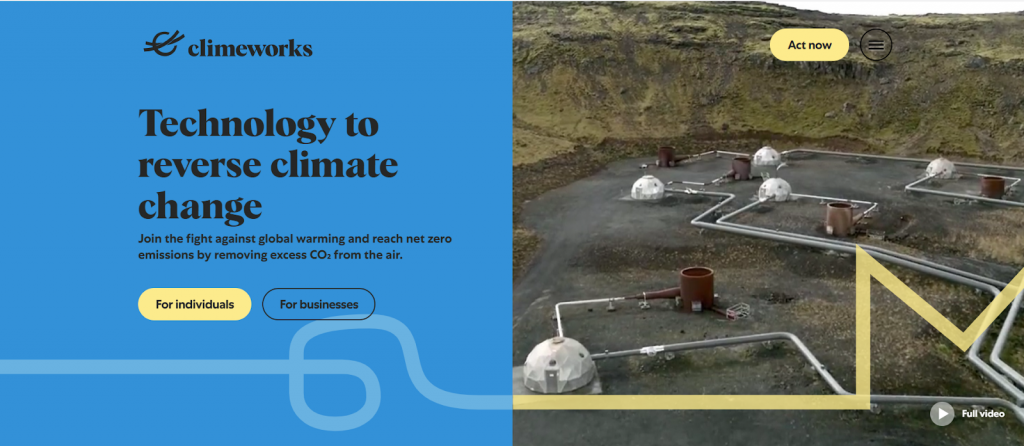
Climeworks is a Swiss direct air capture (DAC) company founded in 2009 by engineering university students Jan and Christoph, who were both shocked at the melting glaciers in the Swiss Alps. Today, their mission is to inspire one billion people to remove CO2 from the air and reverse climate change.
“Let’s reverse climate change”
Climeworks
Project overview: Climeworks’ process can be divided into two parts: carbon capture and carbon storage. Climeworks has specialized machines that first capture CO2 from the air. They then partnered with Icelandic company Carbfix to turn the captured CO2 into stone in less than two years. Carbfix dissolves the captured CO2 in water and injects it underground where it reacts with basalt rock to form solid minerals via natural processes. To date, they have injected over 70,000 tons of CO2 at their Icelandic site.
Carbon offset effectiveness: Climeworks offsets are permanent, measurable, and effective. Carbfix’s process is based on scientific research and has been proven successful at an industrial scale.
Carbon offset costs: Climeworks offers monthly, one-off, or gift carbon purchase options at a cost of $1.20 per 1kg of CO2 removed.
How to get your carbon offsets: You can get your carbon offsets directly from Climework’s webshop, where you can also select how much CO2 you want to remove along with your preferred frequency (monthly, one-off, or gift).
Neustark: Locking Away CO2 in Concrete
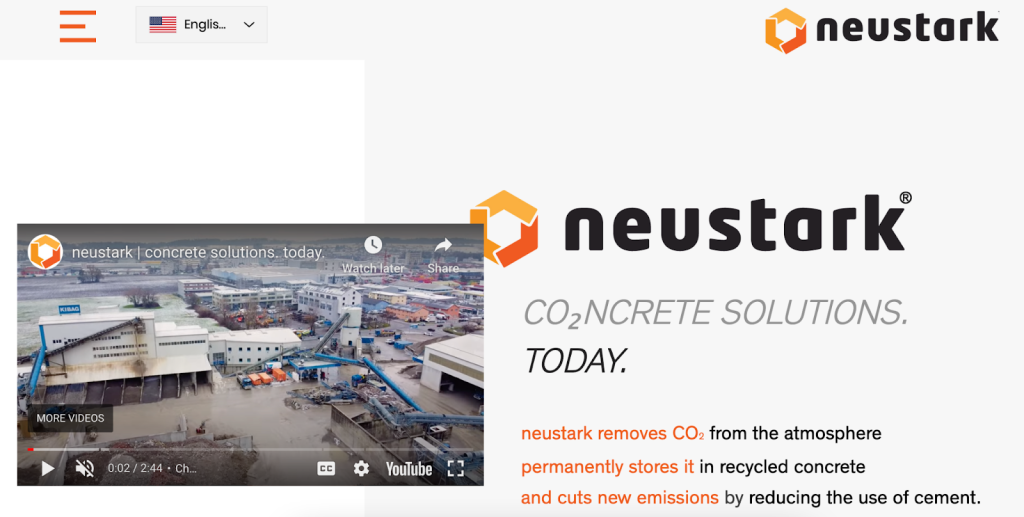
Neustark was founded in 2019 by Johannes Tiefenthaler and Valentin Gutknecht on the shared vision of a solution for the utilization and storage of CO2. Today they have developed technology that produces one of the most climate-friendly concrete. Their mission is to reduce the global construction industry’s carbon footprint by 1 billion tons of CO2 per year by 2050.
“Co₂ncrete Solutions. Today.”
Neustark
Project overview: Neustark removes CO2 from the atmosphere and permanently stores it in recycled concrete via the process of mineralization, what they call their ‘Carbon Dioxide Removal (CDR) service’. Approximately 10kg of CO2 are stored per cubic meter of concrete, and up to 20kg of CO2 emissions are avoided in the concrete production process. This results in a carbon removal efficiency of 95%.
Carbon offset effectiveness: Neustark’s carbon credits are permanent, safe, and only issued for net carbon removal. Their process is also credited by the Gold Standard.
Carbon offset costs: Costs are determined after initial contact.
How to get your carbon offsets: You can contact a Neustark representative to get your carbon offsets.
The Arbor Day Foundation: Inspiring People to Plant, Nurture, and Celebrate Trees
The Arbor Day Foundation was founded in 1972 by John Rosenow to commemorate the 100-year anniversary of Arbor Day, the oldest environmental holiday. Today, they are a nonprofit that has expanded to 55 countries and has planted over 500 million trees. They aim to both plant trees and help people understand their value.
“Let’s grow a movement”
The Arbor Day Foundation
Carbon offset overview: The Arbor Day Foundation has partnered with GreenTrees®, Taking Root, and Ecotierra to support reforestation/afforestation projects in the Mississippi Alluvial Valley (US), Nicaragua, and Peru, respectively. These projects restore degraded agricultural lands, replenish soils, and resort forest canopy.
Carbon offset effectiveness: The Mississippi, Nicaragua, and Peru offset projects are certified according to the American Carbon Registry, Plan Vivo, and the Verified Carbon Standard, respectively. The Arbor Day Foundation’s offset projects also adhere to one or more of the UN’s Sustainable Development Goals.
Carbon offset costs: It costs $40 per 1,000kg of CO2 offset.
How to get your carbon offsets: You can visit Arbor Day’s website to purchase your carbon offsets.
SeaTrees: Regenerating Blue Carbon Coastal Ecosystems
SeaTrees was founded in 2018 as a program of the non-profit organization Sustainable Surf to plant, protect, and restore blue carbon coastal ecosystems. Today, they have 16 active projects worldwide involving mangrove planting, kelp/seagrass/coral reef restoration, and watershed protection.
“We can come together + act now to restore coastal ecosystems.”
SeaTrees
Carbon offset overview: SeaTrees is a nonprofit environmental organization that restores coral reefs, plants mangrove trees, restores kelp forests, and restores watersheds in the US, Indonesia, and Kenya. Their custom blended carbon offset product, the SeaTrees Token, combines carbon credits with innovative blue carbon projects. Each SeaTrees Token purchased sequesters 1 ton of CO2 via Verified Carbon Standard certified offset projects, plants 4 mangrove trees, and creates 1 square foot of kelp forest.
Carbon offset effectiveness: SeaTrees projects are verified according to the Verified Carbon Standard and contribute to multiple UN Sustainable Development Goals. Two of their planting partners also include Eden Reforestation Projects, which are included in our list of the Best Charities for Reforestation.
Carbon offset costs: It costs $22 per 1,000kg of CO2 offset.
How to get your carbon offsets: You can visit their website to purchase your blue carbon offsets.
Native Energy: Changing the World Through Climate Projects
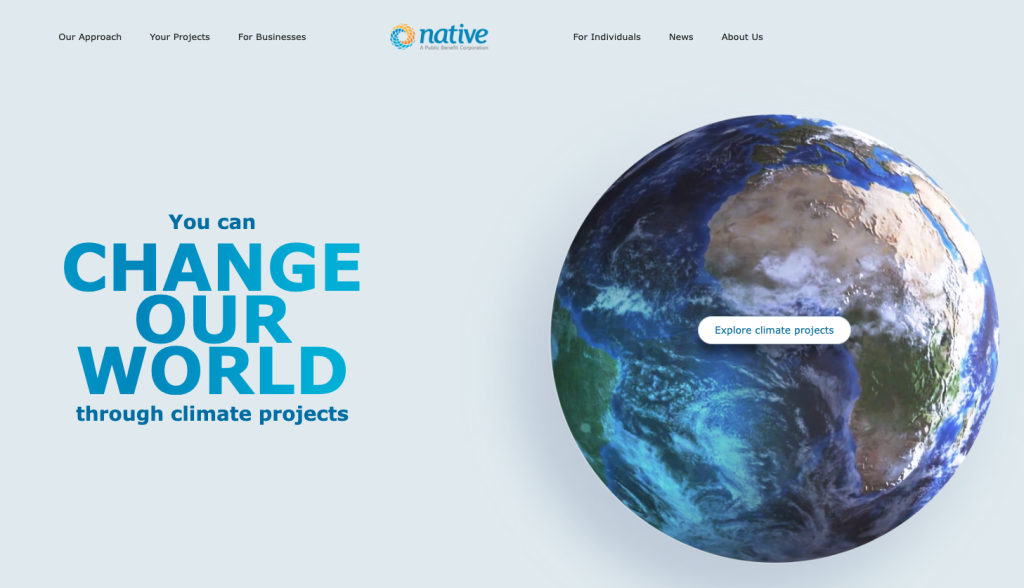
Native Energy was founded in 2000 by Jeff Bernicke as a platform for organizations to implement projects that reduce greenhouse gas emissions and combat climate change.
Today, they offer carbon offsets and renewable energy solutions that provide clients the opportunity to invest and enable the development of new climate projects with direct business benefits.
“Envision your ideal climate solution. Let us build it.”
Native
Carbon offset credit overview: Native Energy offers a variety of regenerative agriculture carbon offset projects including those in Kenya, Canada, Brazil, and the US. For example, their Northern Kenya Rangelands Project is a landscape-scale soil carbon project, and their Noblehurst Family Farm Project is a farm methane power project.
Carbon offset credit effectiveness: Native Energy’s offsets are certified by one of the following leading standards: Gold Standard, Verified Carbon Standard, Climate Action Reserve, American Carbon Registry, Plan Vivo, Climate, or the Community & Biodiversity Alliance.
Carbon offset costs: Costs are determined after initial contact.
How to get your Carbon offsets: You can visit their website to learn more and contact a team member to get your agricultural carbon offsets.
Novocarbo: Repurposing CO2 Into Sustainable Products
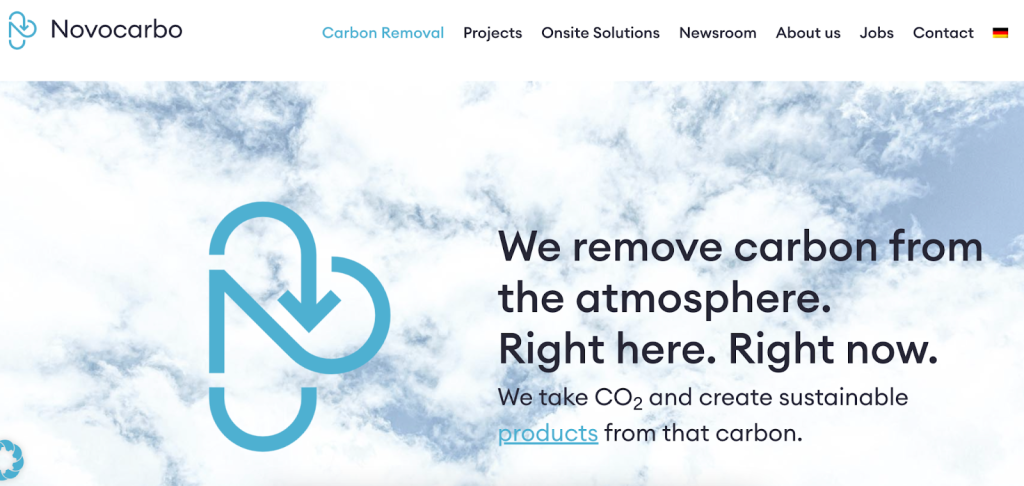
Novocarbo has been capturing CO2 in biochar since 2018, and today they offer one of the first scalable carbon removal solutions on the European market. Their mission is to remove CO2 from the atmosphere now, because our climate can’t wait.
“Because we can scale anywhere”
Novocarbo
Project overview: Novocarbo uses pyrogenic carbon capture and storage (PyCCS), which converts CO2 into regenerative energy and biochar, thereby locking away the carbon for thousands of years. The biochar can be used as soil, as a replacement for cement, and in regenerative agriculture. Through this process, Novocarbo generates carbon credits which they sell through the Puro.earth and Carbonfuture trading platforms.
Carbon offset effectiveness: Novocarbo’s process complies with the European Biochar Consortium (EBC) standard. To be listed on Puro.earth, Novocarbon also had to undergo third-party independent verifiers who audit carbon removal project facilities and issue CORCs; and to be listed on Carbonfuture, Novocarbo have to comply with their high standards, including third-party methodology, certification, and auditing.
Carbon offset costs: Novocarbo uses resellers to sell their carbon capture solutions.
Visit the Puro.earth, or Carbonfuture website to learn more about their respective pricing.
How to get your carbon offsets: You can get your Novocarbo offsets through the Puro.earth, or Carbonfuture websites.
greenSand: Olivine – The Great CO2 Cleaner

greenSand was founded in 2009 by Eddy Wijnker after he realized that Olivine, a mineral, had the potential to clean up CO2. Today, they offer carbon offsets for individuals and businesses and have developed products of olivine-rich rocks that can replace current sand and stone applications. Their mission is to permanently clean up extra CO2 to bring balance back into the Earth’s CO2 cycle.
“We save the earth with stones and sand, will you help?”
greenSand
Project overview: greenSand uses Olivine rocks, which trap CO2 when they come into contact with water. The carbon stored in Olivine rocks is stored permanently, and it is only released if the temperature exceeds 1,600 degrees. For every ton of CO2 purchased, greenSand spreads 1 ton of Olivine, which can in turn absorb 1 ton of CO2.
Carbon offset effectiveness: greenSand is Open Natural Carbon Removal Accounting (ONCRA) certified. ONCRA is a framework for measuring the removal and storage of CO2 via nature-based solutions.
Carbon offset costs: greenSand’s offsets cost $82 per 1,000kg of CO2 offset.
How to get your carbon offsets: You can visit greenSand’s website to get your carbon offsets.
Ecologi: Where Carbon Reduction Partners with Reforestation/Afforestation
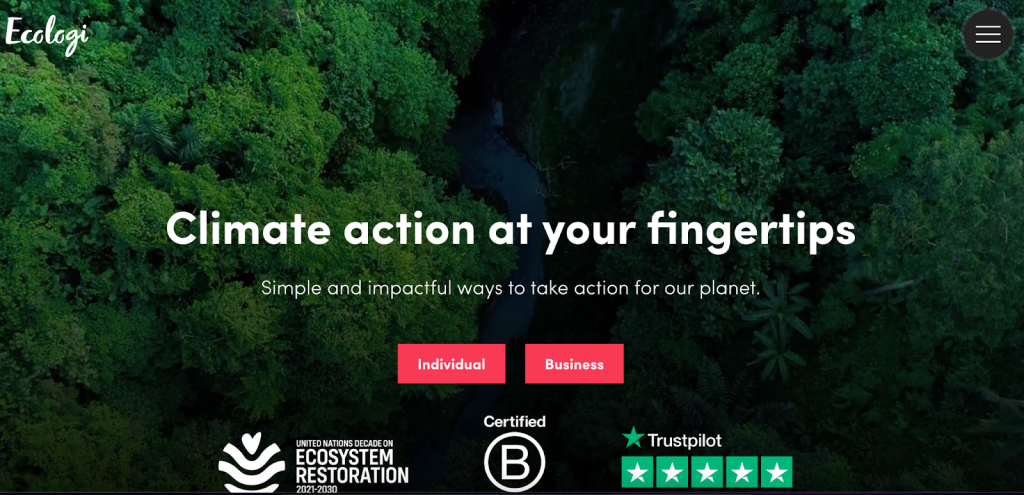
Ecologi was founded in 2019 by Elliot Coad, Lucy Jack, and Alex Price as an answer to the question “what if I put the money from my morning coffee into climate action”? Today, they have funded over 57 million trees, avoided over 2 million tons of carbon, and continue to enable everyday people to tackle the current climate crisis via reforestation and carbon offsetting projects.
“For less than the cost of a cup of coffee per week you can become climate positive.”
Ecologi
Project overview: When you purchase carbon offsets through Ecologi, trees are planted as a bonus, because it takes years for trees to mature and sequester carbon in large quantities.
Examples of reforestation projects include mangrove planting in Madagascar, reforestation in Mozambique, protecting and restoring andean forests in Bolivia, and saving endemic fruit tree species in Morocco. Examples of afforestation projects include the restoring degraded land in Senegal and the forest plantation on degraded grassland in Uruguay projects.
Carbon offset effectiveness: Ecologi’s reforestation/afforestation projects are certified by either the Gold Standard or the Verified Carbon Standard. Their reforestation/afforestation partners include Eden Reforestation Projects, One Tree Planted, and Trees for the Future, all of which are included in our list of the Best Charities for Reforestation.
Carbon offset costs: It costs approximately $6.04 per 1,000 kg of CO2 offset. Ecologi has a personal offset plan where you choose how many trees get planted (12, 24, or 48) for a price ($10.50, $21, or $42 per month). And if you scroll further down, you can plant 1 extra tree in the US for only $1.20 per month.
How to get your carbon offsets: You can visit Ecologi’s website to select your personal carbon offset plan and get your reforestation carbon offsets.
One Tree Planted: A Non-Profit Focused On Global Reforestation/Afforestation
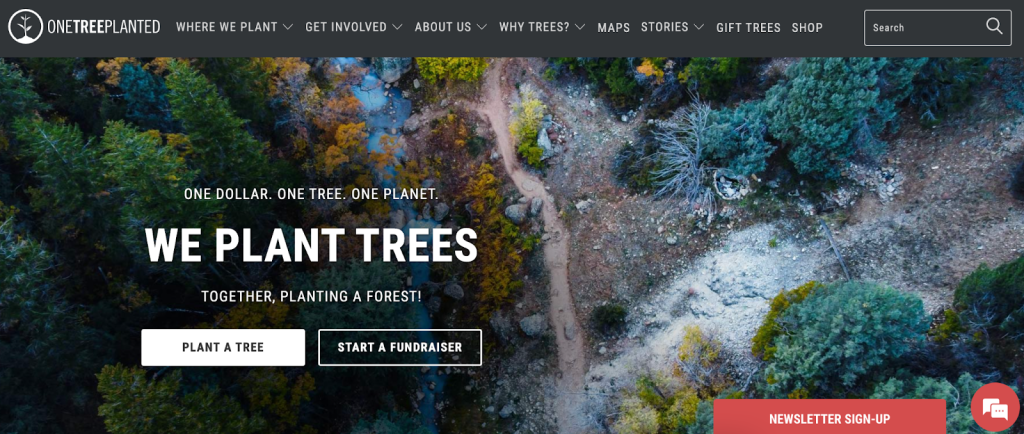
One Tree Planted was founded in 2014 by Matt Hill as a way to make it easier for individuals and businesses to aid in environmental conservation and reforestation across the globe. Today, they have planted over 100 million trees in more than 47 countries.
“One dollar. One tree. One planet.”
One Tree Planted
Carbon offset overview: One Tree Planted is a nonprofit environmental organization that plants trees in North America, Latin America, Africa, Asia, Europe, and the Pacific. Example reforestation offset projects include reforestation in areas affected by wildfires in California and restoring native flora in Romania. An example afforestation offset project includes afforestation in Iceland, which aims to reforest a 150 hectare area previously degraded by overgrazing. One of their more ambitious projects is AFR100, which aims to restore 100 million hectares of deforested & degraded land in Africa.
Carbon offset effectiveness: One Tree Planted’s offsets are certified by the Climate Action Reserve and are retired on a monthly basis.
Carbon offset costs: One Tree Planted offers 3 offset options that offset 10, 20, and 30 tonnes of CO2 at a cost of $20 per 1,000kg of CO2.
How to get your carbon offsets: You can visit their website to view their plans and purchase your carbon offsets.
The Ocean Foundation: A Community Foundation for the Ocean

The Ocean Foundation was founded by Wolcott Henry in 2003 as a community foundation committed to reversing ocean degradation globally. Today, they protect our oceans and coastal ecosystems through conservation initiatives, community foundation services, research and development, and blue carbon offsets.
“Our focus is the ocean. And our community is every one of us who depends upon her.”
The Ocean Foundation
Project overview: The Ocean Foundation has a carbon calculator for flights, households, and businesses as well as a direct carbon offset. Purchases support the planting of seagrass. Seagrass meadows are an important carbon sink and store 11% of the ocean’s buried carbon despite only accounting for only 0.1% of the world’s seafloor.
Carbon offset effectiveness: Their seagrass carbon offsets are certified by the Verified Carbon Standard.
Carbon offset costs: It costs $20 per 1,000kg of CO2 offset.
How to get your carbon offsets: You can visit their website to get your blue carbon offsets.
Husk: Biochar-Based Fertilizers

Husk was founded in 2017 by Heloise Buckland and Carol Rius based on the idea that the private sector can combat social inequality and tackle climate change. To date, they have sequestered over 750 tons of carbon on their mission to create a world with living soils, healthy crops, fair wages, and climate justice.
“Living soils. Healthy crops. Higher margins”
Husk
Project overview: Husk converts rice husks into biochar, fertilizers, and biopesticides via smokeless pyrolysis, preventing the re-emission of carbon into the atmosphere. When biochar-based fertilizers are spread on crops, the sequestered carbon within the products is buried into the soil where it will remain for hundreds of years. The process generates carbon credits that are sold to individuals and businesses looking to lower their carbon footprint.
Carbon offset effectiveness: Husk’s biochar plant follows European Biochar Certification (EBC C-Sink) standards, one of the highest standards for carbon removal.
Carbon offset costs: Husk uses resellers to sell their solutions. Visit Patch’s website to learn more about pricing.
How to get your carbon offsets: You can get your Husk biochar carbon offsets through the Patch website.
Vi Agroforestry: Tropical Agroforestry
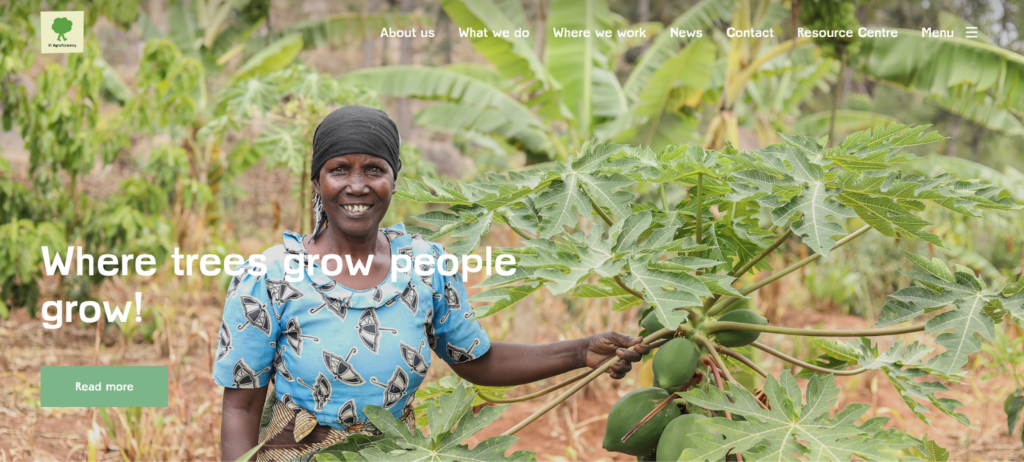
Vi Agroforestry is a Swedish development organization founded in 1983 initially as a tree planting organization. Today, they work with local partners in East Africa to provide agricultural development projects aimed at improving livelihoods.
“For climate and people, now.”
Vi Agroforestry
Project overview: Vi Agroforestry specializes in poverty reduction and environmental improvement through agroforestry and improved farming practices. They currently operate in Kenya, Rwanda, Tanzania, and Uganda. Their Kenya Agriculture Carbon Project (KACP) is the first soil and agricultural carbon project in Africa, which helps 30,000 farmers battle food security and combat climate change. Carbon credits generated from the project benefit small-holder farmers.
Carbon offset effectiveness: The KACP is certified by the Verified Carbon Standard.
Carbon offset costs: It costs approximately $28 per 1,000kg of CO2 offset.
How to get your carbon offsets: You can visit their website to calculate your carbon footprint and get your carbon offsets.
How Effective and Efficient Are Carbon Removal Offsets
In terms of effectiveness, carbon removal offsets can permanently remove carbon from the atmosphere, remove those emissions quickly, and reinforce our carbon sinks, depending on the type of removal. However, they can negatively alter ecosystems, can be difficult to monitor and verify, and do not reduce your own carbon emissions, which can lead to greenwashing.
In terms of efficiency, carbon removal offsets can continue to remove carbon emissions after their project lifespan and have low rates of carbon re-emission, depending on the type of removal. However, they may also lack permanence, may not yet be scaled to compensate for our global emissions, and have varying costs.
Carbon removal offsets are effective at mitigating climate change because they:
- Direct carbon/air capture (DCC/DAC), carbon mineralization, and biochar offsets remove carbon from the atmosphere and store it permanently in underground geological reservoirs.
- DCC/DAC, carbon mineralization, and some blue carbon and agricultural offsets reduce emissions quicker than other nature-based solutions.
- Nature-based solutions such as reforestation, afforestation, blue carbon, and agroforestry store carbon in forests, soils, and oceans, commonly called our carbon sinks.
However, carbon removal offsets can also lack effectiveness because afforestation and carbon mineralization can negatively alter ecosystems if not planned properly, and blue carbon and agricultural carbon offsets can be difficult to standardize, verify, and monitor.
Carbon removal offsets are efficient at reducing CO2 emissions because they:
- Trees continue absorbing carbon long after they mature, which means reforestation, afforestation, and mangrove blue carbon projects can continue to reduce carbon emissions long after the trees have been planted.
- DCC/DAC offsets can have low rates of carbon re-emission when plants are operated by low-carbon electricity. And carbon mineralization offsets store carbon permanently, even if rocks are broken.
However, carbon removal offsets can also lack efficiency because:
- Nature-based carbon removal solutions such as reforestation, afforestation, blue carbon, and agroforestry can lack permanence because carbon storage is reversible.
- DCC/DAC, carbon mineralization, blue carbon, and agricultural offsets are not scaled enough to keep pace with our global carbon emissions due to a lack of technology and few companies engaged in the practices.
Also, costs can vary greatly depending on the type of removal. Carbon removal offsets such as DCC/DAC and carbon mineralization are some of the more expensive methods of carbon removal. But carbon removal offsets involving reforestation, afforestation, blue carbon, and agriculture are relatively cost-effective.
Lastly, carbon removal offsets can also lack effectiveness because they do not reduce your own carbon emissions, which can lead to greenwashing. This occurs when emissions are only offset and not reduced from the source, and the consumer is deceived into thinking they are offsetting their emissions but in reality, they are not.
What Are The 6 Pros and 6 Cons of Carbon Removal Offsets
Carbon removal offsets can be permanent, immediate, cost-effective, have low rates of carbon re-emission, and reinforce our carbon sinks, depending on the specific type of offset. They also allow us to reduce carbon emissions in ways we wouldn’t be able to accomplish individually.
Carbon removal offsets can lack permanence, can be relatively expensive, can negatively alter ecosystems and be difficult to monitor and verify, and may not be scaled to compensate for our global emissions, depending on the specific type of offset. They also do not reduce your own carbon emissions, which can lead to greenwashing.
What Are the 6 Pros of Carbon Removal Offsets
Carbon removal offsets have various pros that make them effective at reducing carbon emissions.
| 6 Pros of Carbon Removal Offsets | Quick Facts |
| #1: Carbon removal offsets can be permanent | Carbon removal offsets such as direct carbon/air capture (DCC/DAC), carbon mineralization, and biochar agricultural offsets can permanently remove carbon from the atmosphere. |
| #2: Carbon removal offsets can reduce CO2 and methane (CH4) emissions quickly | Carbon removal offsets such as DCC/DAC, carbon mineralization, and some agricultural offsets reduce emissions quicker than other nature-based solutions. |
| #3: Carbon removal offsets can be cost-effective | Carbon removal offsets involving reforestation, afforestation, blue carbon, and agriculture are some of the most cost-effective methods of carbon emission reduction. |
| #4: Carbon removal offsets can reinforce our carbon sinks | Carbon removal offsets involving reforestation, afforestation, blue carbon, and agriculture reinforce our terrestrial and marine carbon sinks. |
| #5: Carbon removal offsets can have low rates of carbon re-emission | Carbon removal offsets involving DCC/DAC, carbon mineralization, and biochar have a low rate of carbon re-emission, making them effective at removing carbon. |
| #6: Carbon removal offsets allow us to reduce carbon emissions in ways we wouldn’t be able to accomplish individually | Carbon removal offsets allow us to reduce emissions from activities where sustainable alternatives are not yet widely available. |
What Are the 6 Cons of Carbon Removal Offsets
Understanding the drawbacks of carbon removal offsets is important in order to effectively mitigate climate change.
| 6 Cons of Carbon Removal Offsets | Quick Facts |
| #1: Carbon removal offsets can lack permanence | Carbon removal offsets involving reforestation, afforestation, blue carbon, and agroforestry can lack permanence because they are reversible, nature-based solutions. |
| #2: Carbon removal offsets can be relatively expensive | Carbon removal offsets such as DCC/DAC and carbon mineralization offsets are some of the most expensive methods of carbon removal. |
| #3: Carbon removal offsets can be difficult to standardize, verify, and monitor | Blue carbon and agricultural offsets can be difficult to standardize, verify, and monitor because there are multiple methodologies and governing companies. |
| #4: Carbon removal offsets can negatively alter ecosystems | Carbon removal offsets such as afforestation and carbon mineralization can negatively alter ecosystems if not planned properly. |
| #5: Carbon removal offsets may not yet be scaled to compensate for our global emissions | Carbon removal offsets involving DCC/DAC, carbon mineralization, blue carbon, and agriculture are not yet at a scale where they can compensate for our global carbon emissions. |
| #6: Carbon removal offsets do not reduce your own carbon emissions | If emissions are only offset and not reduced from the source, this could lead to greenwashing, when the consumer is deceived into thinking they are offsetting their emissions but in reality, they are not. |
How Can Carbon Removal Offsets Help Mitigate Climate Change
Climate change is a severe and long-term consequence of fossil fuel combustion. Carbon removal offsets can help mitigate climate change because they eliminate fossil-fuel-derived carbon from our atmosphere which, if left untreated, can remain there for tens of thousands of years and exacerbate the negative effects of climate change.
How is Climate Change Defined
Climate change is arguably the most severe, long-term global impact of fossil fuel combustion. Every year, approximately 33 billion tons (bt) of CO2 are emitted from burning fossil fuels. The carbon found in fossil fuels reacts with oxygen in the air to produce CO2.
“Climate change: changes in the earth’s weather, including changes in temperature, wind patterns and rainfall, especially the increase in the temperature of the earth’s atmosphere that is caused by the increase of particular gasses, especially carbon dioxide.”
Oxford Dictionary
Atmospheric CO2 fuels climate change, which results in global warming. When CO2 and other air pollutants absorb sunlight and solar radiation in the atmosphere, it traps the heat and acts as an insulator for the planet. Since the Industrial Revolution, Earth’s temperature has risen a little more than 1 degree Celsius (C), or 2 degrees Fahrenheit (F). Between 1880-1980 the global temperature rose by 0.07C every 10 years. This rate has more than doubled since 1981, with a current global annual temperature rise of 0.18C, or 0.32F, for every 10 years.
As outlined in the 2015 Paris Climate Agreement, we must cut current GHG emissions by 50% by 2030 and reach net zero by 2050.
How Do Carbon Offsets Generally Help Mitigate Climate Change
Levels of carbon in our atmosphere that cause climate change have increased as a result of human emissions since the beginning of the Industrial Revolution in 1750. The global average concentration of carbon dioxide in the atmosphere today registers at over 400 parts per million. Carbon offsets can help prevent these levels from increasing even more.
When you hear the words “carbon offset”, think about the term “compensation”. Essentially, carbon offsets are removals in GHG emissions that are used to compensate for emissions occurring elsewhere.
Carbon offsets that meet key criteria and verified project standards, are additional and permanent, and are a part of projects that are carried out until the end of their lifespan have the best chance of reducing carbon emissions and therefore reducing climate change.
When we offset CO2 we also slow the rate of global temperature rise, which in turn minimizes the effects of climate change.
How Do Carbon Removal Offsets Specifically Help Mitigate Climate Change
Carbon removal in general can specifically help mitigate climate change because it eliminates atmospheric carbon, which when emitted, can remain in our atmosphere for a long period of time.
More specifically, reforestation, afforestation, and mangrove-planting blue carbon offsets help mitigate climate change because they plant more trees, and trees remove CO2 from the air as they grow. By increasing the number of trees on our planet, we increase the amount of carbon they are capable of storing. The more carbon our forests can sequester, the less carbon there is in our atmosphere.
Direct carbon/air capture (DCC/DAC) and carbon mineralization offsets specifically help mitigate climate change because these methods permanently lock away CO2 for thousands of years with little to no carbon re-emission.
Agricultural carbon offsets such as biochar, agroforestry, and CH4 capture can specifically help mitigate climate change because they reduce CO2 and CH4 emissions in one of the biggest industries worldwide.
Final Thoughts
Climeworks, Neustark, The Arbor Day Foundation, SeaTrees, and Native Energy are the best carbon removal offsets. Novocarbo, Husk, and Vi Agroforestry offer projects involving agriculture, greenSand involving carbon mineralization, Ecologi and One Tree Planted involving reforestation and afforestation, and The Ocean Foundation involving blue carbon.
Carbon removal offsets directly take carbon out of the atmosphere. But for all of the good carbon offsets can instigate, they should not be seen as the only solution to climate change. They are effective at reducing CO2 in the short term, but in the long term, they fail to reduce CO2 enough.
When used in conjunction with direct CO2 reduction measures, carbon offsetting can be much more effective. We should reduce our own carbon footprint as much as possible first, and only then choose the most effective carbon removal offsets.
Stay impactful,

Sources
- U.S. Environmental Protection Agency: Offsets and RECs -What’s the Difference?
- Britannica: Carbon Offset
- David Suzuki Foundation: Are carbon offsets the answer to climate-altering flights?
- American University: What is Carbon Removal?
- South Pole: Carbon Offsets Explained
- Impactful Ninja: What Are Direct Carbon/Air Capture Offsets and How Do They Work
- Impactful Ninja: What Are Carbon Mineralization Offsets and How Do They Work
- Impactful Ninja: What Are Tree Planting Carbon Offsets and How Do They Work
- Impactful Ninja: What Are Afforestation Carbon Offsets and How Do They Work
- Impactful Ninja: What Are Blue Carbon Offsets and How Do They Work
- Impactful Ninja: What Are Agricultural Carbon Offsets and How Do They Work
- Impactful Ninja: What Are Carbon Removal Offsets and How Do They Work? The Big Picture
- Climeworks: Homepage
- Climeworks: Our journey to gigaton scale
- Climeworks: Direct air capture: our technology to capture CO2
- Carbfix: Homepage
- Carbfix: Proven
- Climeworks: Subscriptions
- Climeworks: Choose the gift of carbon removal
- Neustark: Homepage
- Neustark: Remove
- Gold Standard: GSF Registry
- The Arbor Day Foundation: Homepage
- The Arbor Day Foundation: About
- The Arbor Day Foundation: Carbon Offset Donation
- American Carbon Registry: Homepage
- Plan Vivo: Homepage
- Verified Carbon Standard: Homepage
- United Nations Department of Economic and Social Affairs: The 17 Goals
- SeaTrees: Homepage
- SeaTrees: About Us
- SeaTrees: Projects
- SeaTrees: SeaTrees FAQ
- Eden Reforestation Projects: Homepage
- Impactful Ninja: 9 Best Charities for Reforestation
- Native Energy: Homepage
- Native Energy: Mission, Vision, Values
- Native Energy: Northern Kenya Rangelands Project
- Native Energy: Noblehurst Family Farm Project
- Gold Standard: Homepage
- Climate Action Reserve: Homepage
- Climate, Community & Biodiversity Alliance: Homepage
- Novocarbo: Homepage
- Novocarbo: About Us
- Novocarbo: Carbon Removal
- Carbonfuture: Homepage
- Puro.earth: Novocarbo CO2 Removal. Right Here. Right Now
- Carbonfuture: Novocarbo CO2 Removal. Right Here. Right Now
- greenSand: Homepage
- greenSand: Permanent CO2 Compensation
- greenSand: All Products
- greenSand: We are greenSand
- greenSand: Operation of Olivine Stone
- greenSand: Certificate – CO2 Compensation
- Open Natural Carbon Removal Accounting: Homepage
- Ecologi: Homepage
- Ecologi: Reforestation and Carbon Offsetting Projects
- Ecologi: restoring degraded land in Senegal
- Ecologi: forest plantation on degraded grassland in Uruguay
- Ecologi: mangrove planting at Kandrany Madagascar
- Ecologi: reforestation in Mozambique
- Ecologi: protecting and restoring Andean forests in Bolivia
- Ecologi: Saving endemic Moroccoan fruit tree species
- One Tree Planted: Homepage
- Trees for the Future: Homepage
- Ecologi: Ecologi Public Impact & Operations Ledger
- Ecologi: Your Plan
- One Tree Planted: About us
- One Tree Planted: Where We Plant
- One Tree Planted: Plant Trees in California
- One Tree Planted: Plant Trees in Romania
- One Tree Planted: AFR100 – Plant Trees for Africa
- One Tree Planted: Plant Trees in Iceland
- One Tree Planted: Carbon Offset
- The Ocean Foundation: Homepage
- The Ocean Foundation: About the Ocean Foundation
- The Ocean Foundation: Calculator
- The Ocean Foundation: Why Go Blue?
- The Ocean Foundation: Donate to Seagrasss Grow
- Husk: Homepage
- Husk: About Us
- Husk: Biochar
- Husk: CFB
- Husk: ONIX P9
- European Biochar: C-Sink
- Patch: Homepage
- Vi Agroforestry: Homepage
- Vi Agroforestry: Kenya Agriculture Carbon Project (KACP)
- Verified Carbon Standard: Homepage
- Vi Agroforestry: The Climate Calculator
- Carbfix: Protecting Our Climate by Turning CO2 Into Stone
- ClientEarth: What is a carbon sink?
- Organisation for Economic Co-operation and Development: A Global Analysis of the Cost-Efficiency of Forest Carbon Sequestration
- GreenBiz: Blue carbon will be the next frontier of carbon crediting
- Massachusetts Institute of Technology Climate Portal: Soil-Based Carbon Sequestration
- greenSand: Olivine Research & Evidence
- The Institute for Carbon Removal Law and Policy: Nature-Based Solutions
- American University: Fact Sheet – Enhanced Mineralization
- Edie: Carbon offsetting – How are businesses avoiding greenwashing on the road to net-zero?
- How Effective and Efficient Are Carbon Removal Offsets? Here Are the Facts
- Impactful Ninja: Carbon Removal Offsets: All 6 Pros and 6 Cons Explained
- World Nuclear Association: Carbon Emissions from Electricity
- Natural Resources Defense Council: Global Warming 101
- myclimate: What does “net zero emissions” mean?
- United Nations Convention Framework on Climate Change: The Paris Agreement
- National Oceanic and Atmospheric Administration: Climate Change – Atmospheric Carbon Dioxide
- Terrapass: Carbon Offset Projects
- Carbon Offset Guide: Additionality
- Carbon Offset Guide: Permanence




